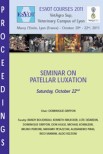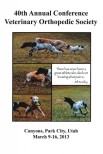A 5 year old male Labrador retriever was presented with an antebrachial lesion characterized by soft tissue swelling that was warm and fluctuant - the owner thought the dog had been injured, but the history was questionable - lameness was not a prominent feature - radiographs were made at the time of entry. Radiographic diagnosis Radiographic diagnosis - the highly destructive lesion was in the radial diaphysis and was characterized by
- Marked cortical destruction with a central lucent area
- A rather well-defined short zone of transition
- Minimal periosteal reaction that appeared to have an intact border that resembled Codman’s triangle both proximal and distal to the lesion (arrows)
- Endosteal scalloping on the opposite cortex was sharply demarcated but did not stimulate any periosteal new bone on that surface
- A more distal medullary lesion was characterized by increased density without any destruction (arrow)
- The lesion did not appear to stimulate any changes in the adjacent ulna
Differential radiographic diagnosis A primary bone tumor must be considered with any destructive long bone lesion -the features that support this diagnosis are:
- Cortical destruction with the central lytic area
the features that fail to support the diagnosis are:
- Location is diaphyseal whereas primary bone tumors are usually metaphyseal/epiphyseal
- Periosteal response is benign in appearance especially the Codman’s triangles whereas primary bone tumors usually have an aggressive periosteal new bone formation
- Zone of transition is rather short whereas primary bone tumors usually have a long zone of transition
- The interface between the central lytic area and the endosteum is sharply defined whereas the destructive zone in primary bone tumors usually is poorly defined
Bone infection (osteomyelitis) probably secondary to a bite wound is another diagnosis for consideration and is supported
- by the nature of the periosteal response
- the short zone of transition
Final radiographic diagnosis
- The radiographic diagnosis was that of a probable primary bone tumor because of the cortical destruction and central lytic area
- The owner did not consent to treatment and only agreed to return the dog at a two week interval or if the dog showed a marked change in use of the limb
Radiographs were made at a 2 week interval at which time the dog was obviously lame and in pain and the radiographs were compared with the original study Radiographic diagnosis on the follow-up study The diagnosis is relatively easy on the follow-up study in which
- The cortical destruction has increased in size
- The size of the central lucent area is increased
- The periosteal reaction is irregular without any pattern - this can be referred to as “amorphous” new bone
- The rather specific patterns referred to as Codman’s triangles are not present
- The lesion border that permitted the evaluation of a short zone of transition is now missing and the zone of transition is now rather long especially on the distal border
- All of the radiographic changes showed a marked increase in aggressiveness of the lesion and were diagnostic of a primary bone tumor - the diagnosis at necropsy was a primary osteosarcoma
- The case is interesting in that the lesion on the first study did not show the typical pattern of malignancy
- There is a rule that any bone lesion that includes cortical destruction must have a primary bone tumor on the differential list
- In this case the owner made the diagnosis easy by refusing treatment and only accepting the offer of a second radiographic study - generally a 7-10 day interval is considered sufficient to permit detection of the marked changes in the radiographic appearance thus confirming a malignant lesion
Primary bone tumor - frequency by cell type
- 80% of malignant primary bone tumors in dogs are osteosarcomas
- 10% chondrosarcoma, 3.5% fibrosarcoma, 3.5% hemangiosarcoma
- 70% of malignant primary bone tumors in cats are osteosarcomas
Osteosarcoma - age
- Mean age 7.5 to 8 yr in dogs (but as early as 1 yr)
- Mean age 10.5 yr in cats
Osteosarcoma - dogs - breed frequency
- Breeds- boxers, great dane dog, saint bernard, german shepherd dog, irish setters, rottweilers, greyhounds
- Giant breeds (>35kg) - 60 x risk
- Large breeds (15 to 35kg) - 8 x risk
- Sex incidence varies with location- Appendicular - males more frequent- Axial - females more frequent
Osteosarcoma - sites in dogs
- Appendicular 3-4 x compared with axial
- Forelimb 1.6 to 1.8 x compared with pelvic limb
- Usually metaphysis/epiphysis- Radius - 23% - (all distal)- Ulna - ?? - Humerus - 19% (59/60 proximal)- Femur - 14% (more distal) - Tibia - 17% (more distal)
- Breed influence on site- Great Dane Dog - 67% distal radius- Boxer - 9% distal radius









